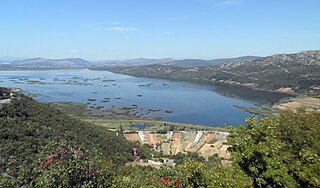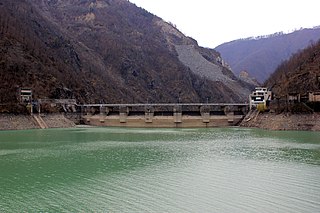
The Herzegovina-Neretva Canton is one of 10 cantons of the Federation of Bosnia and Herzegovina in Bosnia and Herzegovina.

The Neretva, also known as Narenta, is one of the largest rivers of the eastern part of the Adriatic basin. Four HE power-plants with large dams provide flood protection, power and water storage. It is recognized for its natural environment and diversity of its landscape.

Hutovo Blato is a nature reserve and bird reserve located in Bosnia and Herzegovina. It is primarily composed of marshlands that were created by the underground aquifer system of the Krupa River. It is fed from the limestone massif of Ostrvo that divides the Deransko Lake and Svitavsko Lake. The reserve is on the list of BirdLife International's Important Bird Areas. It is the largest reserve of its kind in the region, in terms of both size and diversity. It is home to over 240 types of migratory birds and dozens that make their permanent home in the sub-Mediterranean wetlands surrounding Deransko Lake. In the migration season, tens of thousands of birds fill the lake and its surroundings.

Jablaničko lake is a large artificially formed lake on the Neretva river, right below Konjic where the Neretva expands into a wide valley. The river provided lot of fertile, agricultural land there, before the lake flooded most of it. The lake was created in 1953 after construction of Jablanica Dam near Jablanica in central Bosnia and Herzegovina.

The Čapljina Pumped-Storage Hydroelectric Power Plant is a pumped-storage hydroelectric power plant (PSHPP) or pumped hydroelectric energy storage power plant (PHESPP) type of hydroelectric power plant, whose powerhouse is situated underground near Svitava, in Bosnia and Herzegovina. It's one of country's largest hydroelectric power plants of any type, having an installed electric capacity of 420 MW.
The Grabovica Hydro Power Plant is one of Bosnia and Herzegovina's largest hydro power plant having an installed electric capacity of 117 MW. It was commissioned is 1982, and is operated by JP Elektroprivreda BiH.

The Rama Dam is a concrete-face rock-fill dam on the Rama river, a tributary of the Neretva river, about 4 km (2.5 mi) southwest of the town of Prozor in the Herzegovina-Neretva Canton of Bosnia and Herzegovina.
The Salakovac Hydro Power Plant is one of Bosnia and Herzegovina's largest hydro power plants having an installed electric capacity of 210 MW.
The Buk Bijela Hydro Power Plant is proposed hydroelectric power plant (HPP) on the Drina river in Bosnia and Herzegovina.
The Konjic Hydro Power Plant was proposed hydroelectric power plant (HPP) on the Neretva river near Konjic, Bosnia and Herzegovina, and was supposed to be one of the largest HPPs in the country, with predesigned capacity of 122 MW, but project was cancelled due to organized protests by various NGO's from Bosnia and Herzegovina and abroad.

Konjic is a city and municipality located in Herzegovina-Neretva Canton of the Federation of Bosnia and Herzegovina. It is located in northern Herzegovina, around 60 kilometres (37 mi) southwest of Sarajevo. It is a mountainous, heavily wooded area, and is 268 m (879 ft) above sea level. The municipality extends on both sides of the Neretva River. As of 2013, it has a population of 26,381 inhabitants.

Rakitnica is the main tributary of the first section of the Neretva river, also called Upper Neretva (Bosnian: Gornja Neretva). It meets Neretva from the right, flowing from north to south, between Bjelašnica and Visočica mountains.

The Trebižat is a river in the southern part of Bosnia and Herzegovina, and major right tributary of the Neretva River.

Glavatičevo is a small village in Konjic Municipality, Bosnia and Herzegovina, which is a central village to a group of villages of a wider Glavatičevo, positioned 30 km southeast of Konjic, within a wide Župa Valley straddling the Neretva river. The village and its wider areal, with surrounding villages and the valley, is also referred to as Župa Glavatičevo, or Komska Župa, or simply Župa.

Upper Neretva, is the upper course of the Neretva river, including vast mountainous area surrounding the Neretva, with numerous human settlements, peaks and forests, numerous streams and well-springs, three major glacial lakes near the river and even more scattered across the mountains of Treskavica and Zelengora, in a wider area of the Upper Neretva with its flora and fauna.

Lištica is a sinking river in Bosnia and Herzegovina. It is listed as the second coldest river in Europe, and is prone to constant flooding mostly during winter. The Lištica river connects with the Borak wellspring, which rises at the base of the mountainside on the outskirts of town of Široki Brijeg. The town of Široki Brijeg was named Lištica after the Lištica River during the SFR Yugoslavia (1945–1990) but changed its name when the country dissolved back into Bosnia and Herzegovina.

The Jablanica Dam is an arch-gravity dam on the Neretva River about 4 km (2.5 mi) northeast of Jablanica in the Herzegovina-Neretva Canton of Bosnia and Herzegovina. The dam was constructed between 1947 and 1955 with the primary purpose of hydroelectric power production. The power station was commissioned in two stages, from 1955 until 1958. The first generator was commissioned in February 1955. An upgrade in 2008 increased the installed capacity of the power station from 150 MW to 180 MW. The dam's power station is located about 4.4 km (2.7 mi) to the southeast near Jablanica and discharges back into the Neretva River. It contains six 30 MW Francis turbine-generators for an installed capacity of 180 MW. The difference in elevation between the reservoir and power station afford a hydraulic head of 111 m (364 ft). The dam is 85 m (279 ft) tall and creates Jablanica lake. The dam and power station are owned and operated by Elektroprivreda Bosne i Hercegovine.

The Zalomka is a karstic river in the southern part of Bosnia and Herzegovina and one of the largest sinking rivers in the country and the world. It collects its waters from Gatačko Polje.
Jasenica is a sinking river in Bosnia and Herzegovina. It begins as the Ugrovača river, runs through canyon where it gets new name, the Brina, and flows into the town of Široki Brijeg. Here it connects with the Borak wellspring that rises at the base of the mountainside near Široki Brijeg, thus creating the Lištica river.

Ljuta, also called Dindolka, is one of the main tributaries of the first section of the Neretva river, also called Upper Neretva (Bosnian: Gornja Neretva). It meets Neretva from the right, flowing from north to south, between Treskavica and Visočica mountains.















